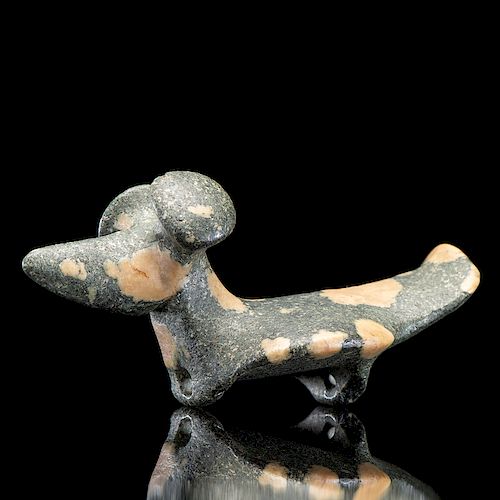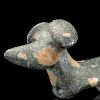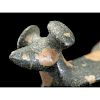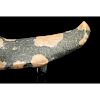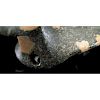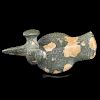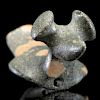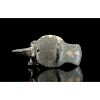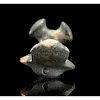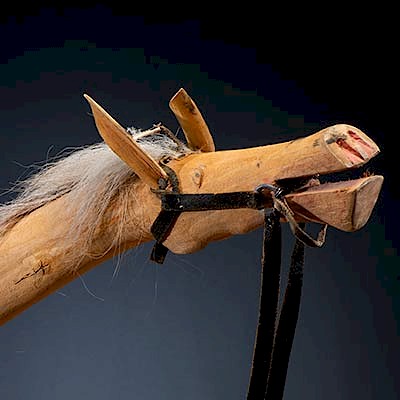A Magnificent Porphyry Popeye Fantail Birdstone, From the Collection of Cameron Parks, Garrett, Indiana
About Seller
6270 Este Ave.
Cincinnati , OH 45232
United States
With offices in Cincinnati, Cleveland and Denver, Cowan’s holds over 40 auctions each year, with annual sales exceeding $16M. We reach buyers around the globe, and take pride in our reputation for integrity, customer service and great results. A full-service house, Cowan’s Auctions specializes in Am...Read more
Two ways to bid:
- Leave a max absentee bid and the platform will bid on your behalf up to your maximum bid during the live auction.
- Bid live during the auction and your bids will be submitted real-time to the auctioneer.
Bid Increments
| Price | Bid Increment |
|---|---|
| $0 | $25 |
| $500 | $50 |
| $1,000 | $100 |
| $2,000 | $250 |
| $5,000 | $500 |
| $10,000 | $1,000 |
| $20,000 | $2,500 |
| $50,000 | $5,000 |
| $100,000 | $10,000 |
About Auction
Apr 5, 2019
A large auction of over 450 lots, featuring the Southwest Collection of Harriet and Seymour Koenig, NY. Highlights of the sale also include a Dance Stick by Joseph No Two Horns (Lakota, 1852-1942), Winter Count by High Dog (Lakota, 19th/ 20th century), a Tsimshian Carved Staff, and much more. Cowan's Auctions dawnie@cowans.com
- Lot Description
Glacial Kame Culture, Late Archaic Period, 3000-500 B.C.
DeKalb County, Indiana
length 4 in. x width 1.75 in.
formed of porphyry, a hard, granitic material; having a rare, bluish hue with large, cream phenocrysts “floating” on matrix; retains original polish
This Porphyry Popeye Fantail possesses attributes required for being considered one of the finest of its type. Large button-shaped eyes expand from the beak, to their greatest diameter. The body expands dramatically from the neck, and then contracts back, before flaring once again into a beautiful fantail. The top of the tail has a slight upturn, which has been noted on only a couple other highly developed, examples. A sharp central ridge extends from the front tip of the beak to the top of the tail. The lower ridges which hold the two perforations, are highly developed, with the rear much larger than the front.
Discovery:
Also known as the Cameron Parks Birdstone, this rare find was unexpectedly discovered in October of 1950. Wellington Young, a young farmer working on Floyd Meyer’s farm, which is located between the towns of Waterloo and Butler in DeKalb County, Indiana, was trailing behind a potato digger, collecting potatoes, when the birdstone was unearthed.
After the find, Wellington sold it to Ralph Staley, a DeKalb County local. Staley who knew of Cameron Park’s interest in prehistoric stone artifacts, contacted and sold the birdstone his wife Mabel. Cameron received this birdstone for Christmas, in 1950.
It should be noted that the farm on which this piece was found, is located near the center of the greatest concentration of discovered birdstones. This area includes the far northeast counties in Indiana; the adjacent far northwest counties of Ohio, and the adjacent counties of southern Michigan.
History:
Birdstone collecting begun in earnest during the second half of the nineteenth century. The Porphyry Popeye Fantail type is considered to be the form which reached the highest degree of artistic development in the North American prehistoric world. This has resulted in being the most sought after and prized by modern collectors.
The use of porphyry in birdstones is rare. The Porphyry Popeye represents less than 10% of all birdstones discovered. But even more extraordinary, are examples exhibiting a wide and expanding fantail.
The Cameron Parks’ birdstone is considered to be among this elite group. Parks himself declared it to be the finest birdstone in the world (Who’s Who in Indian Relics, Vol. III, 1976, page 71). Although a bold statement, he was a proud owner, and may arguably be correct.
Townend’s Birdstones of the North American Indian pictures Parks’ birdstone (color plate IV, pg. 76) alongside two other exceptional examples, namely the Lysander, New York birdstone, curated within the collections of the New York State Museum and the “Smithsonian” birdstone, discovered in Vernon County, Wisconsin. A third, also published in Townsend’s book (pg. 379-B), is the St. Joseph County, Indiana birdstone that resides at the Gilcrease Museum in Tulsa, Oklahoma.
These are distinguished examples due of their highly developed form, large size, condition, and the exceptional material from which they were made. All masterpieces of prehistoric art.
Published:
1951. The Ohio Archaeologist, Vol. 1, No. 3 (back cover and pg. 35)
1959. Townsend, Earl C., Jr., Birdstones of the North American Indian, pg. 383-B and Color Plate IV)
1960. Wachtel, H.C., Who’s Who in Indian Relics, Vol. I (pg. 73)
1960. Central States Archaeological Journal, Vol. 15, No. 1 (pg. 40)
1968. Wachtel, H.C., Who’s Who in Indian Relics, Vol. II (pg. 140)
1972. Parks, Cameron W., and Thompson, Ben W., Who’s Who in Indian Relics, Vol. III (pg 71)
1976. The Redskin, Vol. 11, No. 1 (pg. 5)
1979. Central States Archaeological Journal, Vol. 26, No. 2 (pg. 101)
1980. Thompson, Ben W., Who’s Who in Indian Relics, Vol. V (pp. 91, 96-97)
2009. Central States Archaeological Journal, Vol. 56, No. 3 (pg. 130-131)
2011. Onken, Bobby, Legends of Prehistoric Art, Vol. II (pp. 74, 75, 82-83, 85)
2014. Prehistoric American, Vol. 48, No. 3 (front cover and inside front cover)
2014. Central States Archaeological Journal, Vol. 61, No. 4 (pg. 186)The condition of the Parks Birdstone is nearly as perfect as possible for a 3000-4000-year-old artifact. It has a very small prehistoric nick on the top edge of the left eye and a small nick on the bottom of the rear perforation ridge.Condition
Cowan's strives to sell only authentic artifacts. We view the sheer number of fraudulent artifacts in the marketplace a threat to the collecting hobby, and frankly, place little stock in "Certificates of Authenticity" and prefer to offer old, well-documented artifacts.
We recognize that there may be disagreement between various parties regarding the authenticity of an artifact. Before placing a bid, we invite you, or a surrogate to physically examine any artifact of interest. No artifact deemed spurious by a bidder or his surrogates may be returned after the fall of the auctioneer's hammer.
As you read the catalog and examine the photographs in the catalog, please be aware that some of the artifacts in the collection have been expertly restored. While we recognize that restoration might affect the overall value of an artifact, we believe that these beautifully conserved artifacts still have high value to collectors. Wherever possible, we have noted restoration in the catalog description.
Before the sale, we welcome your questions regarding any of the lots in the catalog and will be happy to provide more photographs or descriptions.
Because of the care we have taken with these descriptions, no restored artifact may be returned after the fall of the auctioneer's hammer." - Shipping Info
-
Buyers are required to pay for all packing, shipping and insurance charges. Overseas duty charges are the responsibility of the successful Bidder. Be aware that for larger and/or valuable items, shipping charges can be substantial. - If there is no shipping amount on listed your invoice, you will need to make arrangements to pick up or ship your purchase through an alternative shipping company. Our shipping department can be contacted at 513.871.1670 (ext. 219) or email shipping@cowans.com. - Shipping charges include insurance for your order while in transit. If you have private insurance we will adjust your charge to include only packing and shipping. - Please allow 14 – 21 days after payment to package and ship your purchase as carefully as possible.
-
- Buyer's Premium



 EUR
EUR CAD
CAD AUD
AUD GBP
GBP MXN
MXN HKD
HKD CNY
CNY MYR
MYR SEK
SEK SGD
SGD CHF
CHF THB
THB